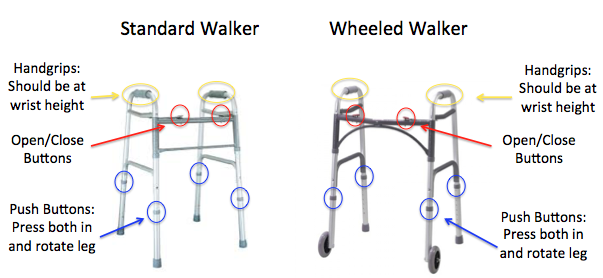Background
A walker is a medical assistive device consisting of a metal frame. The user of the walker will hold onto the handle bars and place the walker in front of them during movement. If it is a Wheeled Walker the user will push it forward, if it is a Standard Walker the user will pick it up and put it forward. Walkers have several points of contact which can consist of plastic tips and wheels. Tennis balls are commonly placed on the bottom back two legs in order to prevent the damaging of floors. Common uses for walkers are people with disabilities, recovering from surgery, people with balance issues, and deconditioning.
Buy on Amazon
Video
Safety
Before using the walker it is important to make sure:
- The walker is correctly fitted
- All buttons are are engaged fully and are not pressed in
- The tips of the walker are not completely worn at the bottom
- The handgrips are attached sturdily and do not move when pressure is applied through them
- No components are loose
- Inspect the walker and parts for dents, cracks, or any irregularities
- DO NOT USE THE WALKER ON THE STAIRS
Stairs
It is NOT recommended to use a walker for ascending or descending stairs due to safety concerns.
References
Durable Medical Equipment. (2018). 1st ed. [ebook] Port Washington, N.Y.: Medical Depot, p.20. Available at: https://www.medline.com/media/catalog/Docs/MKT/LIT124R_CAT_Bath%20Safety%20and%20Walking%20.pdf [Accessed 16 Mar. 2018].

